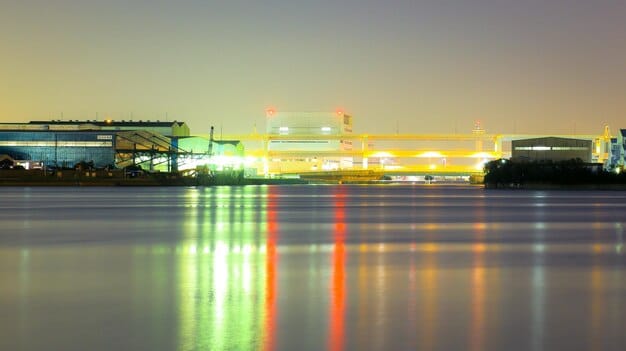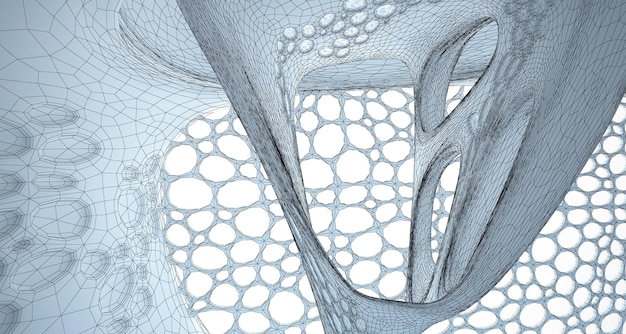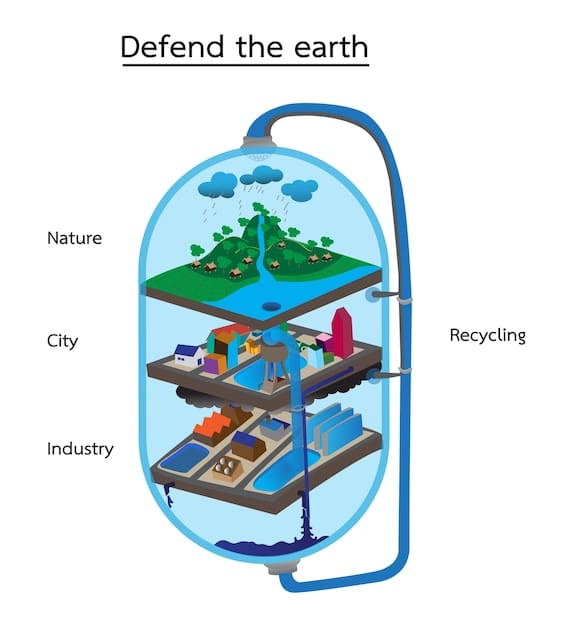Latest Carbon Capture Advancements: Climate Change Mitigation

Recent advancements in carbon capture technology, including direct air capture, mineral carbonation, and enhanced geological storage, offer promising solutions to mitigate climate change by removing carbon dioxide from the atmosphere and industrial sources.
The urgency of climate change demands innovative solutions, and carbon capture technology stands at the forefront. What are the Latest Advancements in Carbon Capture Technology and Their Potential to Mitigate Climate Change? Let’s explore the cutting-edge developments in this critical field.
Understanding Carbon Capture Technology
Carbon capture technology involves capturing carbon dioxide (CO2) emissions from sources such as power plants and industrial facilities, preventing them from entering the atmosphere. This captured CO2 can then be stored permanently or utilized in various applications.
The Basic Process
The fundamental process involves three key stages: capturing CO2, transporting it, and storing it securely. Each stage presents unique challenges and opportunities for technological innovation.
Types of Carbon Capture
Several types of carbon capture technologies exist, each suited to different sources and emission characteristics. Post-combustion capture, pre-combustion capture, and oxy-fuel combustion are among the most common.
- Post-Combustion Capture: Captures CO2 from flue gases after combustion.
- Pre-Combustion Capture: Converts fuel into a mixture of hydrogen and CO2 before combustion, capturing CO2 for storage.
- Oxy-Fuel Combustion: Burns fuel in pure oxygen, producing a concentrated stream of CO2 for easier capture.
These technologies are continually being refined to improve efficiency and reduce costs, making them more viable for widespread implementation.
In summary, understanding the basics of carbon capture technology is crucial for appreciating the advancements that are shaping its future and potential in mitigating climate change.
Direct Air Capture (DAC) Innovations
Direct air capture (DAC) represents a revolutionary approach to carbon capture by extracting CO2 directly from the atmosphere, regardless of the emission source. This technology holds immense potential for addressing historical emissions and achieving net-negative emissions.
How DAC Works
DAC systems use specialized filters and chemical processes to bind CO2 from ambient air. The captured CO2 is then released and prepared for storage or utilization.
Advancements in DAC Materials
Material science plays a crucial role in DAC efficiency. Researchers are developing advanced sorbents that can capture CO2 more effectively and require less energy for regeneration.
- Amine-Based Sorbents: Traditional sorbents with improved stability and capture capacity.
- Metal-Organic Frameworks (MOFs): Highly porous materials with tailored CO2 adsorption properties.
- Ionic Liquids: Solvents with high CO2 solubility and low volatility.

These material innovations are driving down the energy consumption and costs associated with DAC, paving the way for more scalable deployment.
In conclusion, ongoing material science innovations are rapidly accelerating the development and deployment of DAC technology, marking a significant stride towards combating climate change.
Mineral Carbonation: A Novel Approach
Mineral carbonation offers a unique and permanent solution for storing CO2 by reacting it with minerals to form stable carbonates. This process effectively turns CO2 into rock, providing a secure and environmentally benign storage method.
The Mineral Carbonation Process
The process involves reacting CO2 with minerals such as olivine and serpentine. These minerals are abundant and react naturally with CO2 over geological timescales.
Enhancements in Reaction Rates
One of the key challenges in mineral carbonation is the slow reaction rate. Researchers are developing methods to accelerate this process, making it more economically viable.
Methods to Improve Mineral Carbonation
- Pre-Treatment of Minerals: Grinding and thermal activation to increase surface area and reactivity.
- Use of Catalysts: Adding substances to speed up the carbonation reaction.
- Optimization of Reaction Conditions: Adjusting temperature, pressure, and pH to enhance CO2 uptake.
These enhancements are making mineral carbonation a more practical and scalable option for long-term CO2 storage.
In conclusion, mineral carbonation holds significant promise as a permanent and environmentally friendly method for CO2 storage, with ongoing research focused on accelerating reaction rates and reducing costs.
Enhanced Geological Storage Techniques
Enhanced geological storage involves injecting captured CO2 deep underground into suitable geological formations, such as depleted oil and gas reservoirs or saline aquifers. Advanced techniques are improving the efficiency and safety of this storage method.
Selecting Suitable Storage Sites
Careful site selection is crucial to ensure the long-term security of CO2 storage. Factors such as geological structure, permeability, and caprock integrity are carefully evaluated.
Monitoring and Verification
Advanced monitoring technologies are used to track the movement of CO2 underground and verify that it remains securely stored. These technologies include:
Advanced Monitoring Tech
- Seismic Monitoring: Detecting changes in subsurface structure.
- Well Logging: Measuring pressure, temperature, and CO2 concentration in wells.
- Satellite Imaging: Detecting surface deformation indicative of CO2 movement.

These monitoring and verification techniques provide assurance that CO2 is safely and permanently stored underground.
In conclusion, enhanced geological storage is a mature and effective method for large-scale CO2 storage, with ongoing advancements in site selection and monitoring ensuring its long-term security.
CO2 Utilization: Turning Waste into Resource
CO2 utilization involves converting captured CO2 into valuable products, such as fuels, chemicals, and building materials. This approach not only reduces CO2 emissions but also creates new economic opportunities.
CO2 as a Feedstock
CO2 can serve as a feedstock for various industrial processes, replacing traditional fossil-fuel-based resources. This can significantly reduce the carbon footprint of these industries.
Applications of CO2 Utilization
Several applications of CO2 utilization are showing promise, including:
Products from CO2
- Synthetic Fuels: Converting CO2 and hydrogen into liquid fuels.
- Polymers: Using CO2 to create plastics and other polymers.
- Building Materials: Incorporating CO2 into concrete and aggregates.
These applications are driving innovation and creating new markets for captured CO2.
In conclusion, CO2 utilization offers a promising pathway for transforming captured CO2 into valuable products, contributing to both emissions reduction and economic growth.
Policy and Economic Incentives
The widespread deployment of carbon capture technologies requires supportive policies and economic incentives. Governments and organizations are implementing various measures to accelerate the adoption of these technologies.
Government Support for CCS
Governments are providing funding for research, development, and deployment of carbon capture and storage (CCS) projects. Tax credits, grants, and loan guarantees are common forms of support.
Carbon Pricing Mechanisms
Carbon pricing mechanisms, such as carbon taxes and cap-and-trade systems, create an economic incentive for companies to reduce CO2 emissions. This drives investment in carbon capture technologies.
Examples of successful incentive programs
- 45Q Tax Credit (USA): Provides tax credits for CO2 storage and utilization.
- Innovation Fund (EU): Supports innovative low-carbon technologies, including CCS.
These policy and economic incentives are crucial for creating a favorable environment for carbon capture technologies to thrive.
In conclusion, supportive policies and economic incentives are essential for driving the widespread adoption of carbon capture technologies and achieving significant emissions reductions.
| Key Point | Brief Description |
|---|---|
| 🌱 Direct Air Capture | Captures CO2 directly from the atmosphere using advanced materials. |
| ⛏️ Mineral Carbonation | Reacts CO2 with minerals to form stable carbonates, storing CO2 permanently. |
| 🛢️ Geological Storage | Injects CO2 deep underground into geological formations for long-term storage. |
| ♻️ CO2 Utilization | Converts captured CO2 into valuable products like fuels and building materials. |
Frequently Asked Questions
▼
The main goal is to prevent carbon dioxide (CO2) emissions from entering the atmosphere, thereby mitigating climate change by capturing CO2 from various sources.
▼
Unlike other methods that capture CO2 from specific emission sources, DAC extracts CO2 directly from the ambient air, allowing it to address historical emissions.
▼
Government policies, such as subsidies, tax incentives, and carbon pricing, encourage investment in the development and deployment of carbon capture technologies.
▼
Yes, when combined with other sustainability efforts, carbon capture technology offers a substantial contribution to reducing global emissions and addressing climate change.
▼
Successful CO2 utilization includes converting CO2 into synthetic fuels, polymers, and building materials, which can reduce the carbon footprint of these industries.
Conclusion
The latest advancements in carbon capture technology offer a promising path toward mitigating climate change. From direct air capture to mineral carbonation and enhanced geological storage, these innovations, coupled with supportive policies and economic incentives, hold the potential to significantly reduce global emissions and create a more sustainable future.





